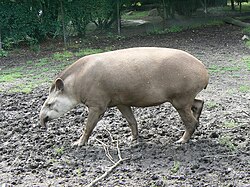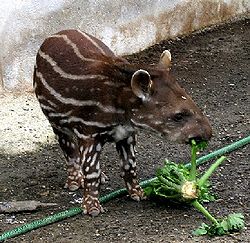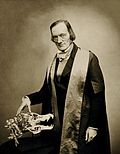Odd-toed ungulate
Odd-toed ungulates are the Perissodactyla, an order of mammals.
| Odd-toed ungulates Temporal range:
Late Palaeocene – Recent | |
|---|---|

| |
| Rhinoceros | |
| Scientific classification | |
| Kingdom: | |
| Phylum: | |
| Class: | |
| Infraclass: | |
| Superorder: | |
| Order: | Perissodactyla Owen, 1848
|
Odd-toed ungulates have an uneven number of toes: Horses have only one toe, rhinoceros have three toes, and tapirs have four toes on the front feet and three toes on the hind feet.
Their digestive system is more basic than the even-toed ungulates. A key difference between the two is that odd-toed ungulates digest plant cellulose in their intestines rather than in one or more stomach chambers as the even-toed ungulates do.
Horses, for example, get much less nutrition out of grass than bovines do. This has the consequence that horses have to stop and feed more often, which in turn makes them more liable to predators. However, horses are very well-adapted for running, more so than many oxen or other Artiodactyls.
The living ungulates are a much-reduced group: the horses (including zebras), the tapirs and the rhinoceros.[1]
Taxonomy
- Order Perissodactyla
- Family Rhinocerotidae
- Family Tapiridae
- Family Equidae
Odd-toed Ungulate Media
The white rhinoceros is the largest living perissodactyl
Restriction of their habitat and poaching threaten the survival of most rhino species, including the Indian rhinoceros shown here
A young Brazilian tapir
Restoration of Palaeotherium, a palaeothere genus first formally described in 1804
Live reconstruction of chalicothere Anisodon grande (formerly Chalicotherium grande)
Eohippus, an early relative of the horse, is one of the oldest-known perissodactyls
References
| Wikispecies has information on: Perissodactyla. |
| Wikimedia Commons has media related to Lua error in Module:Commons_link at line 62: attempt to index field 'wikibase' (a nil value).. |
- ↑ Ronald M. Nowak: Walker's Mammals of the World. 6th edition. Johns Hopkins University Press, Baltimore 1999, ISBN 0-8018-5789-9
+{{{1}}}−{{{2}}}







